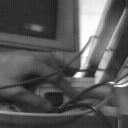Trojan Room coffee pot

The Trojan Room coffee pot was the inspiration for the world's first webcam. The coffee pot was located in the corridor just outside the so-called Trojan Room within the old Computer Laboratory of the University of Cambridge. The webcam was created to help people working in other parts of the building avoid pointless trips to the coffee pot by providing, on the user's desktop computer, a live 128×128 greyscale picture of the state of the coffee pot.[1][2]
History
The camera was installed on a local network in 1991 using a video capture card on an Acorn Archimedes computer. Employing the X Window System protocol, Quentin Stafford-Fraser wrote the client software and Paul Jardetzky wrote the server. When web browsers gained the ability to display images in March 1993, it was clear this would be an easier way to make the picture available. The camera was connected to the Internet in November 1993 by Daniel Gordon and Martyn Johnson. It therefore became visible to any Internet user and grew into a popular landmark of the early web.

At 09:54 UTC on 22 August 2001, the camera was switched off when the computer department moved to its new premises. The pot (a German Krups model, which was the fourth or fifth seen online) was auctioned on eBay for £3,350 to Spiegel Online, the Internet version of the German Der Spiegel magazine.[3] Coverage of the event included front-page mentions in The Times and The Washington Post, as well as articles in The Guardian and Wired.[4]
After being refurbished by employees of Krups free of charge, the pot has been switched on again in the editorial office of Spiegel Online.
In popular culture
- The coffee pot is spoofed in the video game Hitman 2: Silent Assassin. In the "Graveyard Shift" mission the player can cause a distraction by destroying a "coffee camera" in the kitchen.
- The coffee pot is referenced in the protocol specification for the Hyper Text Coffee Pot Control Protocol, proposed in the April Fools' Day RFC 2324.
- The coffee pot was mentioned on the BBC Radio 4 drama The Archers on February 24, 2005.[5]
References
- ↑ Daniel Gordon, Martyn Johnson. "The Trojan Room Coffee Machine". Retrieved 2006-10-26.
- ↑ Quentin Stafford-Fraser. "Trojan Room Coffee Pot resources". Retrieved 2006-10-26.
- ↑ "Coverage on Witness from the BBC". Retrieved 2013-11-26.
- ↑ Quentin Stafford-Fraser. "Blog post listing media coverage of the shutdown". Retrieved 2006-10-26.
- ↑ Clip on Quentin's site
Further reading
- The Life and Times of the First Web Cam: When convenience was the mother of invention, Communications of the ACM, Vol.44, No.7, pp. 25-26, July 2001.
External links
- Trojan Room Coffee Machine
- Internet Archive of the site
- More Trojan Room Coffee Pot resources on Quentin Stafford-Fraser's site
- New coffee pot webcam at the offices of Spiegel Online
- The Trojan Room Coffee Machine at DMOZ
| |||||||||||||||||||||||||||||||||||||||||||||||||||||
